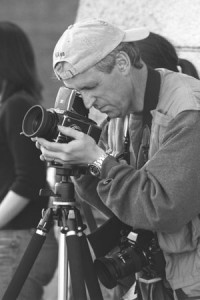When I started to get into photography, it was black and white photography. I had an enlarger in a prior house, but it had been years since I processed a roll of film. At about the age of 11 my daughter Emily wanted a darkroom for Christmas. I was certain she did not mean that, but found that her interest was sparked by summer camp with Mill Street Loft at Oakwood Friends School. I had to get back into photography. I took a class with Emily when she was 11 (Thank you Paul Turner for letting us do that together). It sparked both our interests, which continue today. I took some darkroom courses at Arlington Adult Ed, and brushed up on my old film and photo processing. I scouted out my parent's basement (while they were away) and set up my darkroom. This grew to two enlargers, an archival print washer, prints drying from clothes pins, and a dry mount press. I bulk loaded 35mm film, processed it in my basement, and printed up the street at my parents' house. Hours would fly by in the darkroom, where all of a sudden it was 2 or 3 in the morning. I loved the tactile feel of fiber based paper, watching the print come up in developer, and having control over every step of the photograph. My daughter Emily went on to Oakwood Friends School and continued her photography, then on to RIT for a degree in Photojournalism. She still has black and white prints and cyanotypes hanging in her apartment from those days, but she is all digital, working for NPR as a production assistant in Multimedia, taking pictures for stories and doing photo editing. Over the years I thought I would never do any serious work other than in black and white film and paper in a traditional wet darkroom. Yes, I took a fair amount of color negative film, and lots of slides, but black and white film took my fancy. I loved my Film Nikon cameras and lenses, and got into 6cm by 6cm (us Americans call it 2 1/4) with a twin reflex, and then Bronica cameras (which had Nikkor lenses back then) with an old chrome S2 camera. I still have them, and moved to SQ-A, and SQ-AI cameras and lenses. I liked the larger negative. It was in the darkroom that I first realized my nearsightedness was also accompanied by farsightedness, and I had to get reading glasses for my contacts, and eventually bi-focals. I even fooled around with a 4" by 5" view camera and my Omega D2V enlarger could handle it all. I had a refrigerator full of paper and film.
Here I am at the Brooklyn Bridge on a photo shoot with my Bronica S2, as well as a Nikon F4. Still have them today, but haven't run any film through them.
In 2005 I bought a used Nikon D100 as everyone was talking about digital imaging. I tried color developing in the darkroom, but never liked the complete darkness and chemicals. With digital, I started to use it for color work. I took a lot of images, as most do when you move from film, and started to upgrade my computer, my software, and learn that beast of a program, Photoshop. I think it was Photoshop 5 at that time. Fast forward to today, and I have not shot a roll of film in over three years. My film cameras are in old bags, with the batteries out. I have two desktop computers built for photo editing, a server box of drives as an archive, a networked system, and two photo printers. I love the flexibility of digital printing, and the choices of paper and rendering give you the same choices and feelings as in the darkroom. I still cut my mats and frame my images, and feel I have complete control over the process.
So it is time to take down the darkroom. Michael Gallo Farrell, the wonderful photography teacher at Oakwood Friends School and Mill Street Loft, still uses film and paper and darkrooms. Some of the equipment will go to Oakwood, including a Bronica SQ-A, finder, back and lens so that someone can also have that great experience. I will give other equipment to those who can use it, preferably at a college, school or art center. Kind of sad time for me, but happy to see it go to good use.
Bill Bogle, Jr.


